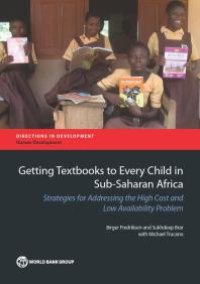
Ebook: Getting Textbooks to Every Child in Sub-Saharan Africa : Strategies for Addressing the High Cost and Low Availability Problem
Author: Birger Fredriksen, Sukhdeep Brar, Michael Trucano
- Tags: Children and politics., Education -- Africa., Education and state -- Africa.
- Series: Directions in Development
- Year: 2015
- Publisher: World Bank Publications
- City: Washington, United States
- Edition: 1
- Language: English
- pdf
Textbooks play a key role in enhancing the quality of learning, especially in the context of low-income Sub-Saharan African (SSA) countries characterized by large class-size, poorly motivated and inadequately trained teachers, and short effective school years. There are also high rates of illiteracy among parents and few reading materials at home for the student to bank on. Despite extensive investments by governments, the World Bank and other development partners, the majority of students in primary and secondary schools in SSA still lack the benefit of access to textbooks and the key reason for this shortage is affordability: textbooks are generally much more costly in SSA than in other developing regions. The need to increase access to key learning resources is of particular urgency because most African countries experience low learning outcomes which in part contributes to a high drop-out rate. Only two-thirds of those who enter school reach the final grade and only about half of these master basic numeracy and literacy skills. And although quality improvement depends on many factors inside and outside the school, there is wide agreement that availability of textbooks is both an indispensable and a cost-effective way of improving the quality of the learning process. A recent World Bank study examined the actual costs of textbooks, the scope for cost reduction, the portion of a national budget countries allocate to teaching and learning materials (TLMs) and hurdles in the way of making textbooks available to student. Some interesting findings from the study - - The availability of affordable textbooks to all students could be dramatically improved by devoting an estimated 3 to 4 percent of the primary education budget and 6 to 7 percent of the secondary education budget - The production process " methods, copyright, length of print runs, effective procurement practices " rather than the production costs should be the target of cost saving strategies - The increased integration of ICTs into education in SSA can provide important opportunities for promoting availability of electronic TLMs but electronic TLMs are not a substitute for printed TLMs including textbooks
Download the book Getting Textbooks to Every Child in Sub-Saharan Africa : Strategies for Addressing the High Cost and Low Availability Problem for free or read online
Continue reading on any device:

Last viewed books
Related books
{related-news}
Comments (0)